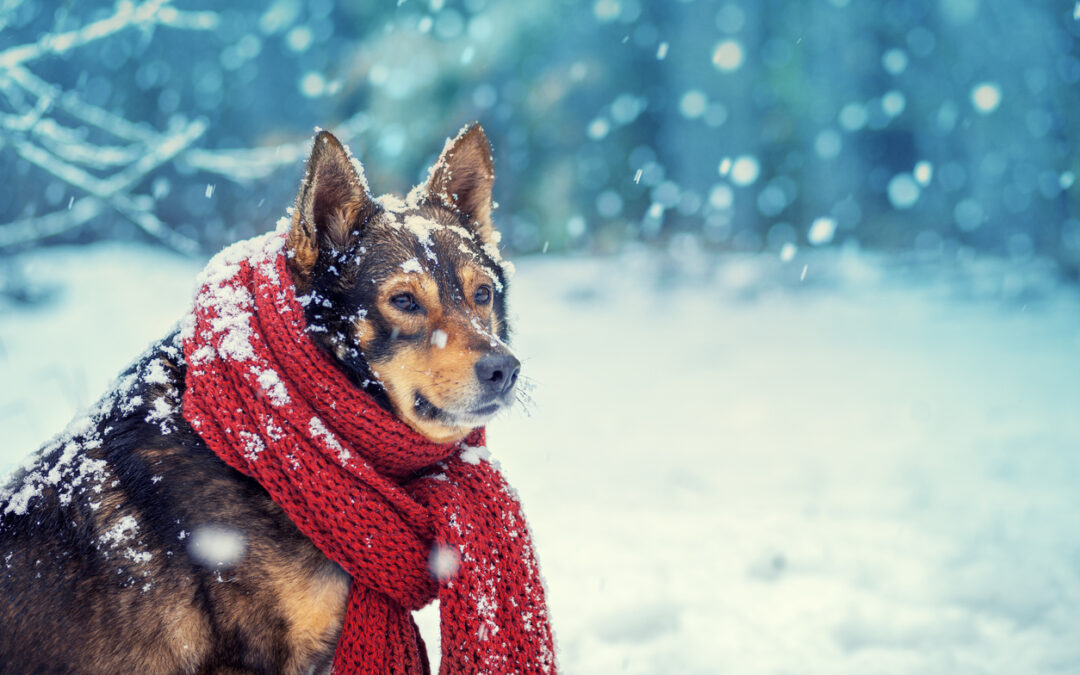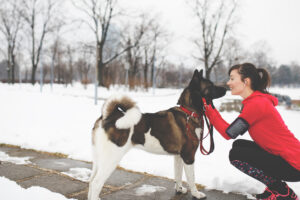How to Take on the Cold Weather with your Pup!
Winter is here, folks. And as winter weather sets in across the country, you will no doubt find yourself spending some time outdoors with your pup. Whether it’s running a few errands, getting in a bold morning run, or playing in the snow, you and your four-legged companion will have to face the elements together (unless, of course, you have somehow mastered the art of avoiding work and staying warm and cozy indoors all season long; in which case, please let us know your secret!). Whatever the case may be, every dog loves a good play day in the snow or a city adventure with their human no matter the temperature. But when your pup is done making snow angels and getting into snowball fights, giving them a quick towel dry as they return indoors is not enough to keep them happy and healthy through the winter months. Below, you’ll find some helpful tips and steadfast rules to live by and incorporate into your pets’ daily regimen. Below, you will see that these tips are not listed in terms of importance; based on your pup’s breed or your region’s climate, some of these useful rules will apply more so than others. Regardless, the winter months are a time to remain vigilant about your pup’s health and ensure that they stay the healthy and happy canine companion you love so much!
Take care of those paws!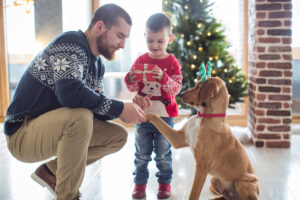
If you’re willing to make the investment, try a pair of dog booties – particularly for smaller, indoor breeds or if you think your pup can tolerate some flashy new footwear; however, if your canine refuses a fresh pair of booties, have no fear! Just be sure to trim the hair on the paws, without cutting it too short. Hair can get wet in the snow and freeze. Conversely, if your pet returns indoors, the hair on the paws can stay wet and cold for a prolonged period of time.
Cosmopolitan Canines and SALTED City Sidewalks
 This rule applies for any dogs that come into contact with salted sidewalks or driveways, or surfaces treated with chemical de-icers. City dogs, in particular, come into contacts with surfaces regularly treated to combat the ice and snow. Salt can be an irritant that can result in irritation and chronic dryness of the paws, so your dog may require a balm to counteract the salt. At the very least, be sure to regularly clean your pet’s paws. Vaseline is another good option, but be sure that they don’t lick it all off! If you’re in the market for something more canine-specific, there are paw balms and rubs available online.
This rule applies for any dogs that come into contact with salted sidewalks or driveways, or surfaces treated with chemical de-icers. City dogs, in particular, come into contacts with surfaces regularly treated to combat the ice and snow. Salt can be an irritant that can result in irritation and chronic dryness of the paws, so your dog may require a balm to counteract the salt. At the very least, be sure to regularly clean your pet’s paws. Vaseline is another good option, but be sure that they don’t lick it all off! If you’re in the market for something more canine-specific, there are paw balms and rubs available online.
Salt/De-Icer Bonus Tip
Salt, as well as chemical de-icing agents, can be toxic to your pup if ingested. While it may not always be possible, do your best to avoid coming into contact with treated areas.
Don’t forget their ears!
 Just like their paws, be sure to wipe down your dog’s ears after their snowy adventures! Wet dog ears, left uncleaned and wet, can lead to painful ear infections.
Just like their paws, be sure to wipe down your dog’s ears after their snowy adventures! Wet dog ears, left uncleaned and wet, can lead to painful ear infections.
Wintertime skin and hair care.
Regular Brushings! Brush your pup’s old fur allows a newer, fuller coat to grow in. It also prevents the fur from clumping and matting, which does not insulate as well can take longer to dry.
Dry winter weather = Dry Skin! Excessive dry winter weather can cause dry fur and skin, which can lead to hot spots that will leave your dog itching, scratching, and biting. To help avoid potential dry skin, lesions, and scabs, brush regularly and be ready to incorporate a supplement or shampoo to combat all that dryness.
Speaking of spending time outdoors…
 Remember, at the end of the day, you are ultimately the puppy-parent and can regulate how much time your furry companion spends outdoors. This has more to do with body temperature regulation, so make sure they get a chance to warm themselves up. This can prevent hypothermia and frostbite.
Remember, at the end of the day, you are ultimately the puppy-parent and can regulate how much time your furry companion spends outdoors. This has more to do with body temperature regulation, so make sure they get a chance to warm themselves up. This can prevent hypothermia and frostbite.
Yes, there are coats for dogs.
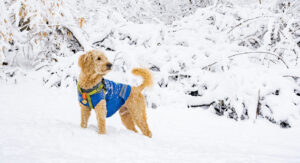 What is one of the first items of clothing you grab before walking outside to face the wintery elements? A warm coat! Naturally, since it’s almost 2018, there are plenty of winter coat and sweater options for your four-legged canine companions, too! A good- insulating coat or sweater- especially if your pup doesn’t have a natural winter coat, like a Husky – can make all the difference in keeping the elements at bay. Older or sickly dogs, as well, are particularly sensitive to the cold weather and need the added insulation.
What is one of the first items of clothing you grab before walking outside to face the wintery elements? A warm coat! Naturally, since it’s almost 2018, there are plenty of winter coat and sweater options for your four-legged canine companions, too! A good- insulating coat or sweater- especially if your pup doesn’t have a natural winter coat, like a Husky – can make all the difference in keeping the elements at bay. Older or sickly dogs, as well, are particularly sensitive to the cold weather and need the added insulation.
Insulation EVERYWHERE!
 If you have an indoor pup, extra bedding – like some big, cozy blankets – that your dog can burrow into make all the difference in combating a cold draft or a sudden late-night temperature drop.
If you have an indoor pup, extra bedding – like some big, cozy blankets – that your dog can burrow into make all the difference in combating a cold draft or a sudden late-night temperature drop.
If your dog sleeps outdoors, be ever-vigilant in keeping the doghouse well-insulated! Even a cold breeze can severely affect your dog’s health. Make sure that the entryway is facing away from the wind to minimize wind exposure, and, when possible, place the doghouse near a windbreak (i.e. your house, trees, barn, etc.). Be sure to keep the interior insulated, too. Straw is a good heat-trap, but some extra blankets or towels work, as well. Just be sure to keep cloth bedding dry.
Drink, Drink, DRINK (Water)!
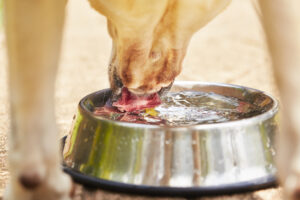 Whether natural or artificial, extra winter layers mean extra hydration. At the very least, hydration supports healthy temperature regulation. Bonus Bowl Tip: If your dog has a water bowl or bucket outside, be sure it is made of a plastic or ceramic material! Metal bowls can freeze and pose a potential health risk to your pup if their tongue comes into contact with the frozen surface.
Whether natural or artificial, extra winter layers mean extra hydration. At the very least, hydration supports healthy temperature regulation. Bonus Bowl Tip: If your dog has a water bowl or bucket outside, be sure it is made of a plastic or ceramic material! Metal bowls can freeze and pose a potential health risk to your pup if their tongue comes into contact with the frozen surface.
Extra food (and Treats!)
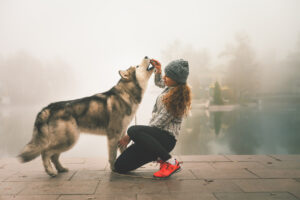 All that time spent outdoors- playing in the snow and making snowmen- means extra food to keep your pet’s caloric intake up. They are burning extra calories to stay warm and maintain their body temperature, so some extra food will help prevent malnourishment and keep them in peak winter condition. Additionally, the added protein can help keep their fur full and healthy.
All that time spent outdoors- playing in the snow and making snowmen- means extra food to keep your pet’s caloric intake up. They are burning extra calories to stay warm and maintain their body temperature, so some extra food will help prevent malnourishment and keep them in peak winter condition. Additionally, the added protein can help keep their fur full and healthy.
Know your breed.
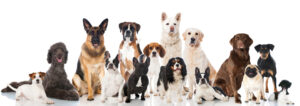 Different breeds require different, specialized needs. This rule is no different when it comes to colder winter months. A husky or Great Pyrenees has different requirements than a miniature Australian Shepherd or toy poodle when it comes to staying healthy and happy during the winter. Utilize online resources like the American Kennel Club and the ASPCA to learn more about the needs of your special pup! Also, remember that your vet is always the best resource for info and helpful ideas specific to the need of your canine companion.
Different breeds require different, specialized needs. This rule is no different when it comes to colder winter months. A husky or Great Pyrenees has different requirements than a miniature Australian Shepherd or toy poodle when it comes to staying healthy and happy during the winter. Utilize online resources like the American Kennel Club and the ASPCA to learn more about the needs of your special pup! Also, remember that your vet is always the best resource for info and helpful ideas specific to the need of your canine companion.

